African Serval Cats
THE AFRICAN SERVAL CAT
Serval Cat (Felis serval)or(Leptailarus serval)
Family Order: Felidae Carnivora
Local names: Mondo (Kiswahili), Emmondo (Luganda and many other languages), Monzo (Kirabai), Engalirao (Lukonjo), Orumberembere (Lugbara), Munjuli (Kinyiha), rndama mweli (Luhya), Lutuku (Lugisu), Kurrbalit (Sebel), Kworo (Lwo), Bisdinaad (Somali)
Measurements
head and body: 67 – 100 cm
height: 54 – 62 cm
tail: 24 – 35 cm
weight: 13 (10 – 18) kg males
11 (8.7 – 12.5) kg females
Color– Spotted patterns of brown, tan, and black (Miniature Cheetah)
Weight– 18 LB. TO 44 LB.
Height– Average of 24 inches at shoulders; long slender legs and body
Life Span– Approx. 20 years
Disposition– Curious, adaptable, playful through out their entire life. They bond closely as kittens for a life long relationship with their owners. Each individual cat has it’s own distinct personality.
Housing– Your home is all that is necessary for a single Serval kept as a house cat but an additional outside enclosure is nice for the feline. The Serval can be litter trained just as the common domestic house cat. Some Servals sleep with their owners and for some this is fun and enjoyable however, a thirty pound cat on a three A.M. hunting excursion through your bedroom can be a memorable experience!
Feed Requirements– We recommend Zu-Preem brand feline diet, which is specifically designed for non-domestic felidae, as the sole source of feed and nourishment for the Serval. Occasionally, some of the Hills Science Feline-CD Diet is a good idea because its hard dry texture is beneficial to the Servals dental health. This is a good preventative measure as you will find most dentists reluctant to treat these fuzzy friendly felines!! The average adult Serval will consume approx. $25.00 dollars worth of Zu-Preem per month which is very comparable to the usual feed cost for the common family pet “Rover”. Both of the above mentioned feeds can be purchased from your local veterinarian’s office.
Health Care– An identical regimen of annual vaccinations and worming programs ,as is required by the common American Short Hair, is all that is necessary to keep the Serval maintained in excellent health. We do recommend having all four paws of your Serval declawed between four to six months of age.
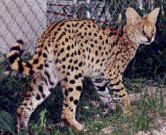 The best description one can give a person that has no idea what an African Serval Cat is would be to say it looks like a miniature cheetah. Most people have seen a cheetah on the Discovery Channel or a National Geographic special, so this at least gives them some idea of what the creature looks like. Of course, the size of the two felines is quite different along with many other differences but the colors and markings of the two felines are similar and a good starting point.
The best description one can give a person that has no idea what an African Serval Cat is would be to say it looks like a miniature cheetah. Most people have seen a cheetah on the Discovery Channel or a National Geographic special, so this at least gives them some idea of what the creature looks like. Of course, the size of the two felines is quite different along with many other differences but the colors and markings of the two felines are similar and a good starting point.
To be more specific, the Serval is one of the few spotted cats not on the endangered species list. The formal biological description of the Serval would be: FAMILY:-felidae, ORDER:-carnivora, SPECIES-felis(leptailurus)serval. The species was formerly termed Leptailurus Serval, with a sub-species called the Servaline because of the different color pattern (more numerous smaller sized spots) until both were found in the same areas of Africa and eventually found to be present in a single litter of cubs.
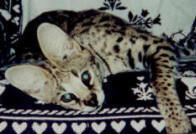 The differences have now been attributed to the slightly different camouflage needed in the different geographical areas in which the cat resides. However, even though it has been determined that these cats with smaller but more numerous spots are not in fact a subspecies, I still hear the term “Servaline-like” used to describe this pattern of markings.
The differences have now been attributed to the slightly different camouflage needed in the different geographical areas in which the cat resides. However, even though it has been determined that these cats with smaller but more numerous spots are not in fact a subspecies, I still hear the term “Servaline-like” used to describe this pattern of markings.
Richard Green, in Wild Cat Species of the World, eloquently describes the Serval as a medium sized elegant looking cat with very long legs, a relatively small head, and very large ears. The ground color of the coat is yellowish buff with under parts pale, almost white. There are black spots on the body which merge into stripes on the neck and upper part of the back. The short tail has spots, which become rings towards the tip, whilst the tip itself is black. The backs of the ears are black with white centers and there are collar markings in the form of black stripes. An adult Serval weighs between 18lbs and 44lbs on average, with the female being slightly smaller in overall size.
An adult Serval stands approx. 24″ at the shoulders and is close to three feet long. The neck can be stretched upwards 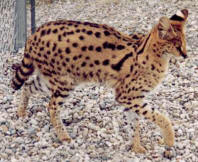
or to the side appearing unusually long. This of course enhances the hunting ability of the cat in the wild as it looks for it’s favorite prey, rodents, in tall grasses.
The extra long legs, especially in the front, help the Serval to reach into rodent holes to capture prey. The metatarsals of the Serval are extra long as opposed to the elongated forearm of the Cheetah. The Cheetah’s longer legs serve to provide greater speed where the Servals gives them more reaching capacity. This isn’t to say Servals aren’t fast but they do not quite posses the Cheetah’s speed. The Serval also feeds on birds and is quite proficient at catching them as they have been noted to jump nearly 15 feet straight up to catch a bird on the wing. In certain situations, the Serval has been known to work with a partner or two (usually male siblings) in order to take small antelope as prey, although the Serval in the wild is usually a solitary animal except during mating periods. Fish as well as rabbits are also high on the menu list for the Serval cat. As you will find out if you eventually own a Serval, they have a great fondness for playing in water which is quite an uncharacteristic trait for many cats.
The Serval cat is distributed widely throughout Africa. They are most common in the open savannas, from lightly bushed country to forests, but particularly near marshy places or rivers. They also are found on high mountain moorlands. In the tall grass a Serval performs his signature style of pouncing up and down in pursuit of mice and other rodents. Their ears are not quite radar but close. Servals often hear their prey and react rather than reacting to the sight of their prey. The Serval can supposedly hear the motion of a rodent as far as 20 feet away in the tall grasses of its natural environment.
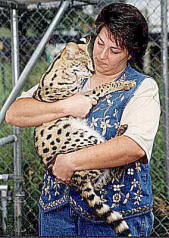 The Serval is mostly a nocturnal animal but sometimes can be diurnal. They are considered mostly a terrestrial cat, as its long legs testify, however it can easily climb trees making it arboreal as well. This is an example of the extreme adaptability of the African Serval Cat.
The Serval is mostly a nocturnal animal but sometimes can be diurnal. They are considered mostly a terrestrial cat, as its long legs testify, however it can easily climb trees making it arboreal as well. This is an example of the extreme adaptability of the African Serval Cat.
The Serval makes a distinctive sound calling out what can be described as a “HOW-HOW-HOW!” This sound actually sounds like the loud chirp of a large bird more than it sounds like anything we would associate with any kind of cat. They also pant much like a dog and very unlike most felines. When aggravated the can become quite “Hissy”. My Servals have made noises much like a repetitive grunt when they get overly excited playing with a weed or something I am moving about on the ground. If they feel they are cornered or in danger they certainly have
a growl just as does the lion or the common domestic house cat.
However unusual, a Serval to most people is still a cat. Each with its own likes and dislikes and with its own individual personality. If bottle raised, some are very close to a common “Lap Cat” while others, with the same up-bringing, don’t care much for being held for any length of time.
Servals have been kept as pets in the past in Africa as well as many other parts of the world for thousands of years just 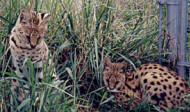 as they have been hunted for their pelts during this same time period. I believe many of the Egyptian vases, so often seen and displayed, are fashioned after the Serval. The cats were kept by the Egyptians. I would assume for practical reasons such as to provide a defense for grains by being the great mousers they are. They were also kept to protect a dwelling from the evils of night until the Egyptian sun god, Rajh, arose in the morning light.
as they have been hunted for their pelts during this same time period. I believe many of the Egyptian vases, so often seen and displayed, are fashioned after the Serval. The cats were kept by the Egyptians. I would assume for practical reasons such as to provide a defense for grains by being the great mousers they are. They were also kept to protect a dwelling from the evils of night until the Egyptian sun god, Rajh, arose in the morning light.
When exactly the breeding in the U.S. of the Serval and the keeping of them as pets began, I haven’t been able to determine with any certainty. But I do know it was somewhere around the turn of the century. As the fur trade boomed in the 1920’s and 30’s, I am sure people took mercy on some and made pets of them. East African Mammals, An Atlas of Evolution in Africa, published by Academic Press, London, mentions that the young will make handsome pets if reared from infancy. It also mentions Servals in captivity living to 19 years old and the females staying fertile until the age of fourteen. Much of the information in this text comes from studies done on Servals kept in captivity as early as 1951.
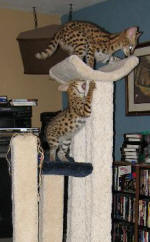 I encourage everyone who owns a Serval to go to the library or the internet and take in as much information as they can on the activities of the African Serval Cat in the wild. This can only help one’s understanding of their instinctual behaviors, thus enhancing the relationship between the cat and human when put in the close relationship we refer to as “Pet” (Serval) and “Owner” (human). However, after living with Servals for sometime I feel sure that my Servals refer to me as “their human”.
I encourage everyone who owns a Serval to go to the library or the internet and take in as much information as they can on the activities of the African Serval Cat in the wild. This can only help one’s understanding of their instinctual behaviors, thus enhancing the relationship between the cat and human when put in the close relationship we refer to as “Pet” (Serval) and “Owner” (human). However, after living with Servals for sometime I feel sure that my Servals refer to me as “their human”.
In my opinion, the Serval is the “top of the line” when it comes to choosing between the exotic cats which are commonly kept in captivity. They are only a little more than twice the size of a common domestic breed which makes their keeping a practical matter. Yet, one couldn’t ask for a more unusual and exotic looking pet. They are much more adaptable to new environments and people than many of the other exotic felines and breed very well in captivity. They are extremely playful with each other as well as with humans they are familiar with. If a Serval is raised from infancy with a great deal of attention and loving care it has been my personal experience that, although they are still a wild creature and not by definition domesticated, they can become comparatively as tame and friendly as many species of animals which are termed domestic. Their feeding requirements and healthcare is similar in cost to that of the domestic cat which once again promotes the Serval as the “top of the line” exotic cat to be kept as a pet or as a propagator of its species.
The best description one can give a person that has no idea what an African Serval Cat is, would be to say it looks like a miniature cheetah. Most people have seen a Cheetah on the Discovery Channel or a National Geographic special, so this at least gives them some idea of what the creature looks like. Of course, the size of the two felines is quite different along with many other differences, but the colors and markings of the two felines are similar, and is a good starting point.
To be more specific, the Serval is one of the few spotted cats not on the endangered species list. The formal biological  description of the Serval would be: FAMILY:-felidae, ORDER:-carnivora, SPECIES-felis(leptailurus)serval. The species was formerly termed Leptailurus Serval, with a sub-species called the Servaline because of the different color pattern (more numerous smaller sized spots) until both were found in the same areas of Africa and eventually found to be present in a single litter of cubs.
description of the Serval would be: FAMILY:-felidae, ORDER:-carnivora, SPECIES-felis(leptailurus)serval. The species was formerly termed Leptailurus Serval, with a sub-species called the Servaline because of the different color pattern (more numerous smaller sized spots) until both were found in the same areas of Africa and eventually found to be present in a single litter of cubs.
The differences have now been attributed to the slightly different camouflage needed in the different geographical areas in which the cat resides. However, even though it has been determined that these cats with smaller but more numerous spots are not in fact a subspecies, I still hear the term “Servaline-like” used to describe this pattern of markings.
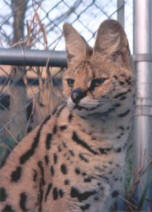 Richard Green, in WILD CAT SPECIES of the WORLD, eloquently describes the Serval as a medium sized elegant looking cat with very long legs, a relatively small head and very large ears. The ground color of the coat is yellowish buff with under parts pale, almost white. There are black spots on the body which merge into stripes on the neck and upper part of the back. The short tail has spots, which become rings towards the tip, whilst the tip itself is black. The backs of the ears are black with white centers and there are collar markings in the form of black stripes. An adult Serval weighs between 18lbs. and 44lbs. on average, with the female being slightly smaller in overall size.
Richard Green, in WILD CAT SPECIES of the WORLD, eloquently describes the Serval as a medium sized elegant looking cat with very long legs, a relatively small head and very large ears. The ground color of the coat is yellowish buff with under parts pale, almost white. There are black spots on the body which merge into stripes on the neck and upper part of the back. The short tail has spots, which become rings towards the tip, whilst the tip itself is black. The backs of the ears are black with white centers and there are collar markings in the form of black stripes. An adult Serval weighs between 18lbs. and 44lbs. on average, with the female being slightly smaller in overall size.
An adult Serval stands approx. Teresa with Serval24″ at the shoulders and is close to three feet long. The neck can be stretched upwards or to the side appearing unusually long. This of course enhances the hunting ability of the cat in the wild as it looks for it’s favorite prey, rodents, in tall grasses.
The extra long legs, especially in the front, help the Serval to reach into rodent holes to capture prey. The metatarsals of the Serval are extra long as opposed to the elongated forearm of the Cheetah. The Cheetah’s longer legs serve to provide greater speed where the Servals gives them more reaching capacity. This isn’t to say Servals aren’t fast but they do not quite posses Cheetah speed. The Serval also feeds on birds and is quite proficient at catching them as they have been noted to jump nearly 15 feet straightServals in grass up to catch a bird on the wing. In certain situations, the Serval has been known to work with a partner or two (usually male siblings), in order to take small antelope as prey, 
although the Serval in the wild is usually a solitary animal except during mating periods. Fish as well as rabbits are also high on the menu list for the Serval cat. As you will find out if you eventually own a Serval, they have a great fondness for playing in water which is quite an uncharacteristic trait for many cats.
The Serval cat is distributed widely throughout Africa. They are most common in the open savannas, from lightly bushed country to forests, but particularly near marshy places or rivers. They also are found on high mountain moorlands. In the tall grass a Serval performs his signature style of pouncing up and down in pursuit of mice and other rodents. Their ears are not quite radar’s but close. Servals often hear their prey and react rather than reacting to the sight of their prey. The Serval can supposedly hear the motion of a rodent as far as 20 feet away in the tall grasses of it’s natural environment.
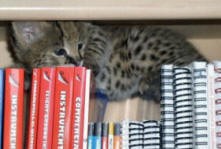 The Serval is mostly a nocturnal animal but sometimes can be diurnal. They are considered mostly a terrestrial cat, as it’s long legs testify, however it can easily climb trees making it arboreal as well. This is an example of the extreme adaptability of the African Serval Cat.
The Serval is mostly a nocturnal animal but sometimes can be diurnal. They are considered mostly a terrestrial cat, as it’s long legs testify, however it can easily climb trees making it arboreal as well. This is an example of the extreme adaptability of the African Serval Cat.
The Serval makes a distinctive sound calling out what can be described as a (HOW-HOW-HOW!). This sound actually sounds like the loud chirp of a large bird more than it sounds like anything we would associate with any kind of cat. They also pant much like a dog and very unlike most felines. When aggravated the can become quite “Hissy”. My Servals have made noises much like a repetitive grunt when they get overly excited playing with a weed or something I am moving about on the ground. If they feel they are cornered or in danger they certainly have
a growl just as does the lion or the common domestic house cat.
However unusual a Serval is to most people, it is still a cat. Each with its own likes and dislikes and with its own individual personality. If bottle raised, some are very close to a common “Lap Cat” while others, with the same up-bringing, don’t care much for being held for any length of time.
Servals have been kept as pets in the past in Africa as well as many other parts of the world for thousands of years just 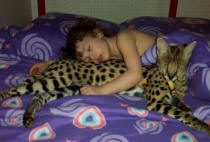 as they have been hunted for their pelts during this same time period. I believe many of the Egyptian vases, so often seen and displayed, to be fashioned after the Serval. The cats were kept by the Egyptians. I would assume for practical reasons such as to provide a defense for grains by being the great mousers they are. They were also kept to protect a dwelling from the evils of night until the Egyptian sun god, Rajh, arose in the morning light.
as they have been hunted for their pelts during this same time period. I believe many of the Egyptian vases, so often seen and displayed, to be fashioned after the Serval. The cats were kept by the Egyptians. I would assume for practical reasons such as to provide a defense for grains by being the great mousers they are. They were also kept to protect a dwelling from the evils of night until the Egyptian sun god, Rajh, arose in the morning light.
When exactly the breeding in the U.S. of the Serval began and the keeping of them as pets in the U.S. began, I haven’t been able to determine with any certainty. But I do know it was somewhere around the turn of the century. As the fur trade boomed in the 1920’s and 30’s, I am sure people took mercy on some and made pets of them. East African Mammals, An Atlas of Evolution in Africa, published by Academic Press, London, mentions that the young will make handsome pets if reared from infancy. It also mentions Servals in captivity living to 19 years old and the females staying fertile until the age of fourteen. Much of the information in this text comes from studies done on Servals kept in captivity as early as 1951.
I encourage everyone who owns a Serval to go to the library or the internet and take in as much information as they can on the activities of the African Serval Cat in the wild. This can only help one’s understanding of their instinctual behaviors, thus enhancing the relationship between the cat and human when put in the close relationship we refer to as “Pet” (Serval) and “Owner” (human). However, after living with Servals for sometime I feel sure that my Servals refer to me as, “their human”.
In my opinion, the Serval is the “top of the line” when it comes to choosing between the exotic cats which are commonly kept in captivity. They are only a little more than twice the size of a common domestic breed which makes their keeping a practical matter. Yet, one couldn’t ask for a more unusual and exotic looking pet. They are much more adaptable to new environments and people than many of the other exotic felines and breed very well in captivity. They are extremely playful with each other as well as with humans they are familiar with. If a Serval is raised from infancy with a great deal of attention and loving care it has been my personal experience that, although they are still a wild creature and not by definition domesticated, they can become comparatively as tame and friendly as many species of animals which are termed domestic. Their feeding requirements and healthcare is similar in cost to that of the domestic cat which once again promotes the Serval as the “top of the line” exotic cat to be kept as a pet or as a propagator of its species.
PURCHASING YOUR AFRICAN SERVAL CAT
Valley Exotics Serval Guarantee
All kittens are bottle fed and hand raised with lots of human exposure and T.L.C.! Prices include: Your bottle fed & hand raised kitten as well as a Vet. Health Certificate (breeders of live animals can not guarantee a life span; however, a buyer has 48 hours after they take possession of their Serval to take the kitten to a veterinarian of their choice so at that POINT IN TIME; Valley Stables and Exotics, our vet., the buyer, and the buyer’s vet. ALL AGREE this is a healthy kitten.), USDA Point of Origin Papers, and post-purchase support to help with any questions that may arise. Transportation via Delta Pet First Live Animal Cargo for all continental U.S. customers. Our goal is a HAPPY BUYER, a HEALTHY KITTEN, and HOLDING THE HIGHEST STANDARD OF INTEGRITY, while representing the Exotic Alternative Livestock Industry. We will do all we can to earn your repeat business and your personal recommendation to your friends and associates! U.S.D.A.- USDA BREEDER LICENSED FACILITY U.S.D.I.-U.S. Dept. of Fish & Wildlife Import/Export License U.S.D.I.-U.S. Fish and Wildlife Service Division of Management Authority-C.I.T.E.S. Permits Acquired for International Sales
